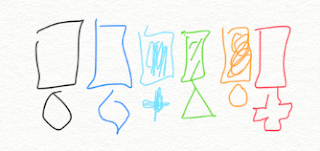Caveats:
This is a group exercise and great for team building. At certain times during the session some people's emotions might rise due to frustration at being misunderstood.
As coach you MUST manage the level of frustration (a little is good, too much is bad) in order to allow the group to fully experience and gain from the steps below. Most participants however are quick to see the simulation for what it is and self-control themselves accordingly. If you feel unsure, practice with a smaller group of friends, for instance, who can safely give you feedback throughout to ensure you are able to facilitate it correctly to the intended benefits.
Always remain on the safe side - for your sake and for your participants' also!
Required:
- Enough labels to get people into groups of 6 - preferably the labels are on little hats so that the people who are labelled do not know their own label (sometimes I use post-its stuck to foreheads but this does not work in warm sweaty conditions, sometimes paper tape/medical tape but have the same problem with sweaty foreheads, sometimes name badges tied on short strings under people's chins).
- Labels should be written (or use symbols) big enough so that other people can read them from 2-3 feet away.
- Labels suggested in
Quick Team-Building Activities for Busy Managers: 50 Exercises That Get Results in Just 15 Minutes
by
Brian Cole Miller include "laugh at me", "disagree with me", "leader", "brown noser", and many more - *BUY THE BOOK*. I've also used Belbin's team roles for labels, as well as Belbin team role opposites (see
Coaching with Belbin for details). Sometimes I just make them up based on the group and behaviours I have observed.
- Printouts for half the group of
Stephen R Covey's
The 7 Habits of Highly Effective People
(*BUY THE BOOK AND READ FOR FULL DETAILS*) Young Lady:
- Printouts for half the group of
Stephen R Covey's
The 7 Habits of Highly Effective People
(*BUY THE BOOK*) Old Lady:
- A digital projector and computer in order to show the group
Stephen R Covey's
The 7 Habits of Highly Effective People![]()
(*BUY THE BOOK*) Both Ladies picture:
- 15 minutes for the first "Label Game" session
- 15 minutes for the second "Believing is Seeing" session
- 15-30 minutes for open group discussion to ensure lesson properly understood and people back to normal
Step 1:
Explain the basics of the "Label Game" to the participants:
- Everyone will receive a "secret" (from them) label that they should not see before the end of the exercise
- No one should tell someone else what their label is
- The groups will be given 7 minutes to plan something (department party, a new fun game, who to choose to evacuate a doomed earth, survive for 24 hours in a desert/artic, etc)
- As the group discusses, the participants must proact/react to the label of the person
- By the end of 7 minutes, people will be asked what they think their label is, before being allowed to look
Step 2:
Break the group into sub-groups of 6, distribute and place the labels on each member so that they are unable to see their own label.
Step 3:
Start the timer! Remind the participants about good
timebox strategies to ensure they succeed with their discussion. Help with time keeping.
Step 4:
Time up! Let the groups discuss amongst themselves and get an indication of how many people realised within 7 minutes of simple discussion, what label they were wearing! Usually >75% correctly guess or infer their label based on how others were interacting with them.
Step 5:
Open the discussion up to the whole group. Good questions like "How did it feel to be treating people according to their label?", "How did it feel to be treated according to a label that was not visible to you?", "What about the labels we're treating each other with continuously in the day to day work?", "What are the dangers of labels?", "What are the pros of having labels?", "How do our labels affect us?", "Labels versus Job Title?" and see what thoughts and feelings are provoked by the group.
Be strict with your own time management as there is still the second session to run!
Step 6:
Get people to become 1 group again, this time split them down the middle.
Step 7:
Without making it obvious that there are 2 different pictures being given out, distribute the "Young Lady" above facedown to half the group, and distribute the "Old Lady" above facedown to the other half of the group.
Ask the participants to turn over the picture and stare at it for 30 seconds, and then to put it away. Help them with timekeeping and ensuring they're focussing on their own picture only.
Step 8:
With the pictures away, turn on the projector and show the group the "Both Ladies" picture.
Step 9:
Ask the participants to stick their hands up if they recognise the picture. Now ask 1 "random" person from the "Old Lady" group what they see. Then ask 1 "random" person from the "Young Lady" group what they see.
Step 10:
Now ask the whole group to raise their hands those who see an Old Lady? And then ask those to raise their hands who sees a Young Lady? Act confused and ask how is it possible - surely they're looking at exactly the same, unmoving picture on the screen - how could it be that people are seeing different things? And then ask who sees both an Old Lady and a Young Lady?
The groups are usually quite fun and energised by this time so allow them to discuss and try to resolve the different perceptions they have. People will come up to the screen and start tracing out the different curves, arguing, getting frustrated, getting amused and slowly all or most of the group will eventually see both pictures. (as an aside, what does it mean if someone is unable, even after a lot of help, to see both ladies?)
Step 11:
Now explain it the way Stephen R Covey does: "It's not logical, it is psychological!"..."the way we see the problem IS the problem!"
Step 12:
And now ask similar questions of the Label Game session. Ask how this kind of knowledge, this insight might have changed how they approached problems in the past, and how they will approach problems in the future? Are the problems restricted to work problems, or are "people problems" also now more approachable? And so on.
Before running this session, I strongly recommend buying both books linked above and reading them properly for more many more details than I've summarised here.
I find the 2 exercises even more beneficial for individuals I am coaching who attend, especially if they have already covered
Belbin's Team Role Inventory Theory,
Myers Briggs Type Indicator and
Preferred Auditory, Visual or Kinaesthetic Communication Styles. For additional benefit, these sessions, run before coachees attempt their first
feedback gathering from peers, also help to give people more self confidence in the collection, in the giving, and in the understanding of the content+emotion they receive from other people. We are all human, even if often it appears we are, or they, are not! ;-)





